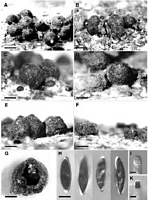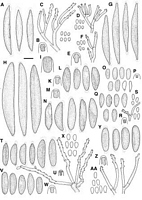|
 Rosellinia dingleyae Rosellinia dingleyae
BiostatusPresent in region - Indigenous. Endemic
Images (click to enlarge)
Caption: Fig. 13 Rosellinia dingleyae. A-F, Stromata, C showing remnants of subiculum; G, Vertical
section of stroma; H, Ascospores, 2nd to 4th showing germ slit; I, Asc | 
Caption: Fig. 8 A-D, Rosellinia arcuata, PDD 41969: A, Ascospores; B, Ascus apical ring; C,
Conidiophores and conidia on the host; D, Conidiophores and conidia on OA; E-G, R.
freycinetiae, PDD 20580: E, Ascus a |
Article: Petrini, L.E. (2003). Rosellinia and related genera in New Zealand. New Zealand Journal of Botany 41(1): 71-138 (http://www.rsnz.org/publish/abstracts.php).
Description: Subiculum evanescent, extension restricted to stromata, chocolate brown, felty, covering
completely young stromata, absent in mature material. Stromata (475)617 ± 99(750) µm high,
(425)602 ± 78(675) µm wide (n = 10), subglobose to cupulate, brown when young, black at
maturity, sometimes seated on a disk, solitary or 2-3 fused together, crowded, during
development gradually emerging from the subiculum. Ostioles pointed to papillate.
Ectostroma 25-50 µm thick, black. Entostroma brown. Perithecia detached in older material.
Ascus apical rings (6.7)7.5 ± 0.5(8.1) µm high, upper and lower width 4.8-5.7 µm (n = 5), J+,
dark blue. Ascospores (26)30.7 ± 2.6(36) µm long, (6.7)8.8 ± 0.6(10) µm wide (n = 60),
inequilaterally ellipsoidal, often with pinched ends, brown to dark brown, with sigmoid germ
slit about 2.3 of the spore length, both extremities and flat side surrounded by a slimy sheath.
Culture on OA cream-coloured, felty to velutinous, sterile.
Habitat: HOST: Macropiper excelsum.
MATRIX: Decorticated wood.
Notes: ETYMOLOGY: In honour of the New Zealand mycologist J. M. Dingley, who collected the
type specimen and several other Rosellinia specimens deposited at PDD.
NOTES: Rosellinia dingleyae differs from R. chusqueae and R. franciscae by its larger
ascospores (Fig. 9B). Ascospores of R. dingleyae have a shorter germ slit than those of R.
chusqueae, but larger than that of ascospores of R. franciscae.
|